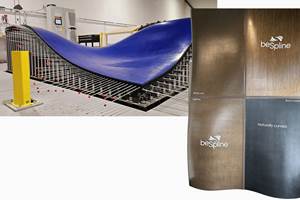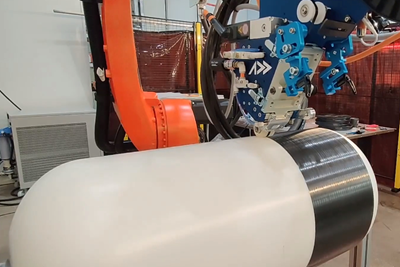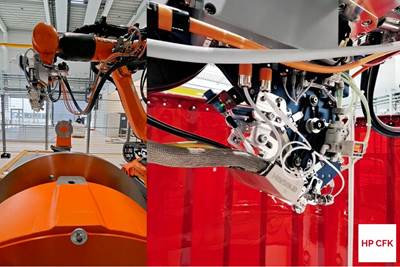Plug-n-play AFP/ATL equipment, adaptive mold and integration solutions eases adoption
CAMX 2024: Addcomp distributes its AFP-XS systems and now adaptive molds, works with customers to design and install custom systems and develops its capabilities with new partnerships.
Share
Source | Addcomp
Addcomp began as a startup company that designs reliable and user-friendly composites manufacturing systems. Part of the IND Group in Sherbrooke, Canada, with bespline (Sherbrooke), Addcomp offers plug-n-play automated fiber placement (AFP) with AFP-XS from Addcomposites (Espoo, Finland), a system that mounts onto almost any robotic arm and is easy to program using its own Addpath software. The modular, lightweight system offers small companies access to automated layup via lease or purchase at a fraction of the cost of bigger industrial systems currently used by aerospace OEMs.
Addcomp is a North American distributor for AFP-XS systems. It also offers AFP-X multi-tow AFP heads, with optional tape winding and the SCF3D continuous fiber additive manufacturing (AM) system. The automation company also works with North American customers to design, optimize and install complete integrated systems customized to meet their needs including cell size, small to large robots, rotary tables, linear rails, additional axes for winding, a tape slitting machine for in-house materials production and installation support and training.
Furthermore, Addcomp has recently signed a partnership with Adapa A/S (Aalborg, Denmark), to distribute and install its adaptive molds in North America. Addcomp comes to this collaboration with 3 years of experience through its use manufacture bespoke doubly curved composite panels by beSpline.
There have been many Addcomp equipment installations, including at the Quebec Composites Development Centre (CDCQ), Purdue University, Polytechnic Montreal, National Research Council Canada and Composite Energy Technologies.
Related Content
-
Design for manufacturing, assembly and automation enables complex CFRP telescope supports
Airborne delivered two mirror support structures for the FYST and SOLAT telescopes, assembling 26,300 components while maintaining near-zero CTE, strict tolerances on 6.5 × 6.5 × 1.8-meter assemblies.
-
Airbus video highlights RACER compound helicopter first flight
Launched as part of a Clean Sky 2 program, a compound design — rotor, split fixed-wing, propulsive propellers — uses composites to cut fuel consumption and emissions by 20%.
-
ASCEND program completion: Transforming the U.K.'s high-rate composites manufacturing capability
GKN Aerospace, McLaren Automotive and U.K. partners chart the final chapter of the 4-year, £39.6 million ASCEND program, which accomplished significant progress in high-rate production, Industry 4.0 and sustainable composites manufacturing.
Related Content
Design for manufacturing, assembly and automation enables complex CFRP telescope supports
Airborne delivered two mirror support structures for the FYST and SOLAT telescopes, assembling 26,300 components while maintaining near-zero CTE, strict tolerances on 6.5 × 6.5 × 1.8-meter assemblies.
Read MoreAirbus video highlights RACER compound helicopter first flight
Launched as part of a Clean Sky 2 program, a compound design — rotor, split fixed-wing, propulsive propellers — uses composites to cut fuel consumption and emissions by 20%.
Read MoreASCEND program completion: Transforming the U.K.'s high-rate composites manufacturing capability
GKN Aerospace, McLaren Automotive and U.K. partners chart the final chapter of the 4-year, £39.6 million ASCEND program, which accomplished significant progress in high-rate production, Industry 4.0 and sustainable composites manufacturing.
Read MorePlant tour: BeSpline/Addcomp, Sherbrooke, QC, Canada
Composites automation specialist increases access to next-gen technologies, including novel AFP systems and unique 3D parts using adaptive molds.
Read MoreRead Next
Addcomposites highlights novel composites manufacturing developments
AFP-XS and AddPath updates, new AFP and continuous AM systems, upcoming webinars and blog content are available to interested industry members.
Read MoreIFW’s AFP installation enhances thermoplastic structure production
Commissioned AddComposites AFP manufacturing cells with humm3 flashlamps are located at IFW’s Stade and Garbsen facilities to expand R&D services.
Read MoreComposites end markets: New space (2025)
Composite materials — with their unmatched strength-to-weight ratio, durability in extreme environments and design versatility — are at the heart of innovations in satellites, propulsion systems and lunar exploration vehicles, propelling the space economy toward a $1.8 trillion future.
Read More






